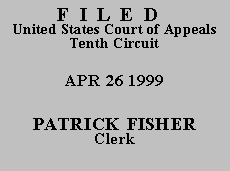 UNITED STATES COURT OF APPEALS
UNITED STATES COURT OF APPEALS
 UNITED STATES COURT OF APPEALS
UNITED STATES COURT OF APPEALS
FOR THE TENTH CIRCUIT
Plaintiff - Appellee,
v.
PAUL S. ALDANA,
Defendant - Appellant.
No. 98-4201
(D.C. No. 98-CR-122-03-S)
(D. Utah)
Once a notice of appeal has been filed in a criminal case, the district court
lacks jurisdiction to rule on a Rule 35(b) motion to reduce sentence. United
States v. Bingham, 10 F.3d 404, 405 (7th Cir. 1993); United States v. Sanzo, 831
F.2d 671, 672 (6th Cir. 1987); Fed. R. App. P. 4(b). The "question thus arises as
to the proper procedure to follow when a Rule 35(b) motion is made during the
pendency of an appeal." Bingham, 10 F.3d at 405. The preferred procedure is
outlined in Bingham:
Where a party moves for sentence reduction under Rule 35(b) during the
pendency of an appeal, it must request that the district court certify its
inclination to grant the motion. If the district court is inclined to
resentence the defendant, it shall certify its intention to do so in writing.
The government (or the parties jointly) may then request that we remand by
way of a motion that includes a copy of the district court's certification
order.
Id.
Having described the preferred procedure, we must determine the
appropriate resolution of the case at hand, where there has been no certification
order but we know the district court is inclined to grant the Rule 35(b) motion.
We conclude the best approach is to vacate the district court's order granting the
Rule 35(b) motion since it lacked jurisdiction over the case and remand to the
district court for resentencing. Once the district court resumes jurisdiction of the
case, it can then properly rule on the government's Rule 35(b) motion.
The district court's order granting the government's Rule 35(b) motion is
VACATED and this case is REMANDED to the district court for resentencing
consistent with this opinion.
The motion to withdraw filed by defendant's counsel is DENIED as moot.
The mandate shall issue forthwith.
Entered for the Court
Per Curiam
*. This order and judgment is not binding
precedent, except under the
doctrines of law of the case, res judicata, and collateral estoppel. The court
generally disfavors the citation of orders and judgments; nevertheless, an order
and judgment may be cited under the terms and conditions of 10th Cir. R. 36.3.
UNITED STATES OF AMERICA,
Before PORFILIO, KELLY, and BRISCOE, Circuit
Judges.
Defendant Paul Aldana pleaded guilty to one count of armed bank robbery,
in violation of 18 U.S.C. § 2113(a) and (d), and was sentenced to fifty-one
months' imprisonment. After Aldana filed a notice of appeal challenging his
sentence, the government filed a Fed. R. Crim. P. 35(b) motion asking the district
court to reduce Aldana's sentence because Aldana had assisted the government in
a related case after his sentencing. Notwithstanding the pendency of this appeal,
the court purported to grant the government's motion and to resentence Aldana to
twenty-four months' imprisonment.
Click footnote number to return to corresponding location in the text.
![]() | Keyword |
Case |
Docket |
Date: Filed /
Added |
| Keyword |
Case |
Docket |
Date: Filed /
Added |
![]() (13618 bytes)
(13618 bytes)
![]() (6896 bytes)
(6896 bytes)
Comments to: WebMaster,
ca10 [at] washburnlaw.edu.
Updated: April 27, 1999.
HTML markup © 1999, Washburn University School of Law.
URL: http://ca10.washburnlaw.edu/cases/1999/04/98-4201.htm.